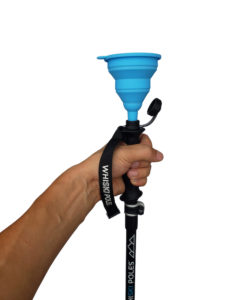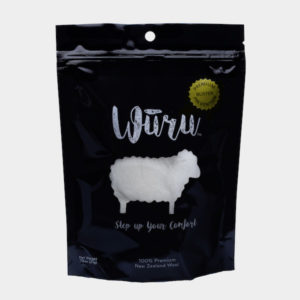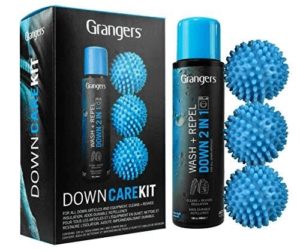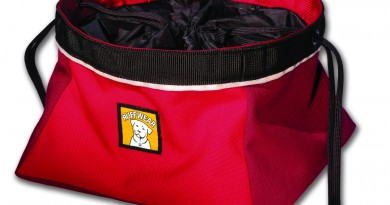Great Gear or Gimmicks?
Sometimes new products come out that have us scratching our heads. Are they great or gimmicks? We called some in to test and here are the best.
Spring is a time for tailgate parties, enjoying the last snow and getting your hiking gear ready for summer. These items just might make those longer March days better.
Pole Flasks
Even considering ski poles that double as flasks brings up all sorts of questions about your priorities. But it also offers possibilities: tailgates, furtive parties on the slopes, BYO to the mountaintop bar, or the tamer  idea of simply using them to hydrate during a skin (as long as your liquid doesn’t freeze). WhiskiPoles ($189) are essentially aluminum ski poles that are hollow so they can hold 8 ounces of liquid each. Unscrew the handles, use a funnel as you pour in the liquid, screw the handle back on tightly and you’re locked and loaded to go. The poles feel solid and seem to work as well as most, with minimal sloshing when full (though a higher swing weight). The poles come with baskets and small shot glasses too. The biggest problem with them was cleaning them so if you do buy these, we recommend avoiding beverages that leave residues. On the gimmick-to-good scale, we were pleasantly surprised and give this a 4 out of 5.
idea of simply using them to hydrate during a skin (as long as your liquid doesn’t freeze). WhiskiPoles ($189) are essentially aluminum ski poles that are hollow so they can hold 8 ounces of liquid each. Unscrew the handles, use a funnel as you pour in the liquid, screw the handle back on tightly and you’re locked and loaded to go. The poles feel solid and seem to work as well as most, with minimal sloshing when full (though a higher swing weight). The poles come with baskets and small shot glasses too. The biggest problem with them was cleaning them so if you do buy these, we recommend avoiding beverages that leave residues. On the gimmick-to-good scale, we were pleasantly surprised and give this a 4 out of 5.
Better Blister Care?
When a package of Wuru ($10.95) arrived, we wondered if someone was pulling wool over our eyes—or our feet. The .75 oz bag of pure New Zealand wool looks like it came straight from the cleanest,whitest sheep you’d ever find. It’s cozy soft and the idea of applying it to a blister on  your heel or hot spot on your toes—as the New Zealanders do, seems to make sense. That’s what sports marketer Matt Disney thought. After spending his honeymoon hiking in New Zealand, Disney launched Wuru. After all, wool absorbs moisture, insulates and provides a soft cushion. The directions tell you to apply a generous amount and the package implies there’s enough for 30 uses. A video on the website (wuruwool.com) shows how to wrap the wool (you don’t tape it) and how to pull a wool sock on over it. And that’s the rub (sorry, bad pun): it took several tries before the wool stayed in place. Then all was well and good—until, after about an hour of hiking, the wool began to bunch up. We might attribute that to user error—after all, Kiwis have been doing this for centuries, right?
your heel or hot spot on your toes—as the New Zealanders do, seems to make sense. That’s what sports marketer Matt Disney thought. After spending his honeymoon hiking in New Zealand, Disney launched Wuru. After all, wool absorbs moisture, insulates and provides a soft cushion. The directions tell you to apply a generous amount and the package implies there’s enough for 30 uses. A video on the website (wuruwool.com) shows how to wrap the wool (you don’t tape it) and how to pull a wool sock on over it. And that’s the rub (sorry, bad pun): it took several tries before the wool stayed in place. Then all was well and good—until, after about an hour of hiking, the wool began to bunch up. We might attribute that to user error—after all, Kiwis have been doing this for centuries, right?
A Down Care Kit
Any time someone takes a cleaning product and puts it in a fancy box, we raise an eyebrow and scrutinize the price. Grangers Down Care Kit ($23), however, lives up to its price tag. The kit comes with three, reusable spiky plastic balls, designed to fluff up down, and a 10 ounce  bottle of cleaner that claims it also waterproofs. The balls do work better than tennis balls, especially on down sleeping bags, which always seem to bunch up. And the cleaner works as well as any other product at removing dirt. If it can also extend the life of a product (many cleaning products have chemicals that can break down the protective layer of a fabric) and help waterproof down, that’s a bonus we were not able to verify. However, Granger also has a Performance Repel ($7.27) spray that can be applied after washing as well as a range of other cleaning products.
bottle of cleaner that claims it also waterproofs. The balls do work better than tennis balls, especially on down sleeping bags, which always seem to bunch up. And the cleaner works as well as any other product at removing dirt. If it can also extend the life of a product (many cleaning products have chemicals that can break down the protective layer of a fabric) and help waterproof down, that’s a bonus we were not able to verify. However, Granger also has a Performance Repel ($7.27) spray that can be applied after washing as well as a range of other cleaning products.
Hybrid Skishoes
There’s a trend in skishoes—think of them as either short freeheel skis that can be used with snowboots or snowshoes that glide—and Tom Gibson is on it. Gibson invented the Tracker Skishoes ($216), small, wide, ski-shaped pieces of high density polyethylene plastic with ![]() fishscales and metal teeth that grip the snow so you don’t slide back, but allow enough glide to let you shuffle forward. The skishoes come with a Redfeather binding and a specially-designed hinge adapter, as used on snowshoes. For skiers, there’s the option of using a NNN or NNNBC (backcountry) binding as well as the Salomon SNS binding. You can also customize them with removable crampons, climbing skins and even three-pin bindings (available at trackerskishoes.com). The wider platform and the short length (they measure 6.75 inches wide and 33 inches long) make it far easier for a non-skier to use in deep snow than a ski and still get a sense of gliding. If you’re going up a steep hill, though, you might miss the traction of a snowshoe.
fishscales and metal teeth that grip the snow so you don’t slide back, but allow enough glide to let you shuffle forward. The skishoes come with a Redfeather binding and a specially-designed hinge adapter, as used on snowshoes. For skiers, there’s the option of using a NNN or NNNBC (backcountry) binding as well as the Salomon SNS binding. You can also customize them with removable crampons, climbing skins and even three-pin bindings (available at trackerskishoes.com). The wider platform and the short length (they measure 6.75 inches wide and 33 inches long) make it far easier for a non-skier to use in deep snow than a ski and still get a sense of gliding. If you’re going up a steep hill, though, you might miss the traction of a snowshoe.

